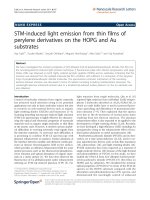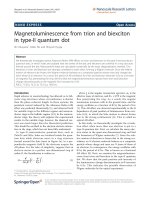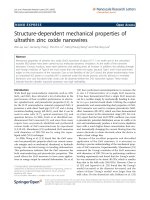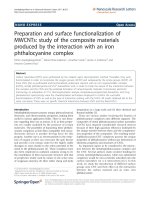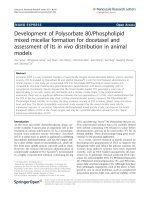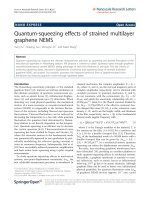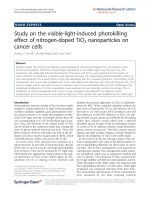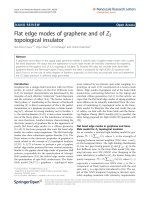Xu et al. Nanoscale Research Letters 2011, 6:355 pot
Bạn đang xem bản rút gọn của tài liệu. Xem và tải ngay bản đầy đủ của tài liệu tại đây (917.22 KB, 6 trang )
NANO EXPRESS Open Access
Quantum-squeezing effects of strained multilayer
graphene NEMS
Yang Xu
1*
, Sheping Yan
1
, Zhonghe Jin
1*
and Yuelin Wang
2
Abstract
Quantum squeezing can improve the ultimate measurement precision by squeezing one desired fluctuation of the
two physical quant ities in Heisenberg relation. We propose a scheme to obtain squeezed states through graphene
nanoelectromechanical system (NEMS) taking advantage of their thin thickness in principle. Two key criteria of
achieving squeezing states, zero-point displacement uncertainty and squeezing factor of strained multilayer
graphene NEMS, are studied. Our research promotes the measured precision limit of graphene-based nano-
transducers by reducing quantum noises through squeezed states.
Introduction
The Heisenberg uncertainty principle, or the standard
quantum limit [1,2], imposes an intrinsic limitation on
the ultimate sensitivity of quantum measurement sys-
tems, such as atomic forces [3], infinitesimal displace-
ment [4], and gravitational-wave [5] detectio ns. When
detecting ve ry weak physical quantities, the mechanical
motion of a nano-resonator or nanoelectromechanical
system (NEMS) is comparable to the intrinsic fluctua-
tions of the systems, including thermal and quantum
fluctuations. Thermal fluctuation can be reduced by
decreasing the temperature to a few mK, while quantum
fluctuation, the quantum limit determined by Heisen-
berg relation, is not directly dependent on the tempera-
ture. Quantum squeezing is an efficient way to decrease
the system quantum [6-8]. Thermomechanical noise
squeezing has been studied by Rugar and Grutter [9],
wheretheresonatormotioninthefundamentalmode
was parametrically squeezed in one quadrature by peri-
odically modulating the effective spring constant at
twice its resonance frequency. Subsequently, Suh et al.
[10] have successfully achieved parametric amplification
and back-action noise squeezing using a qubit-coupled
nanoresonator.
To study quantum-squeezing effects in mechanical
systems, zero-point displacement uncertainty, Δx
zp
,the
best achievable measurement precision, is introduced. In
classical mechanics, the complex amplitudes, X = X
1
+
iX
2
, where X
1
and X
2
are the real and imaginary parts of
complex amplitudes respectiv ely, can be obtained with
complete precision. In quantum mechanics, X
1
and X
2
do not commute, with the commut ator [X
1
, X
2
]=iħ/
M
eff
w, and satisfy the uncertainty relationship ΔX
1
ΔX
2
≥
(ħ/2 M
eff
w)
1/2
. Here, ħ is the Planck constant divided by
2π, M
eff
=0.375rLWh/2 is the effective motional dou-
ble-clamped film mass [11,12], r is the volumetric mass
density, L, W, and h are the length, width, and thickness
of the film, respect ively, and w =2f
0
is the fundamental
flexural mode angular frequency with
f
0
= {[A
(
E/ρ
)
1/2
h/L
2
]
2
+ A
2
0.57T
s
/ρL
2
Wh}
1/2
,
(1)
where E is the Young’s modulus of the material, T
s
is
the tension on the film, A is 0.162 for a cantilever and
A is 1.0 3 for a double-clamped film [13]. Therefore,
Δx
zp
of the fu ndamental mode of a NEMS device with a
double-clamped film can be given by Δx
zp
= ΔX
1
=
ΔX
2
=(ħ /2 M
eff
w)
1/2
. In a mechanical system, quantum
squeezing can reduce the displacement uncertainty Δx
zp
.
Recently, free-standing graphene membranes have
been fabricated [14], providing an excellent platform to
study quantum-squeezing effects in mechanical systems.
Meanwhile, a graphene membrane is sensitive to exter-
nal influences, such as atomic forces or infinitesimal
mass (e.g., 10
-21
g) due to its atomic thickness. Although
graphene films can be used to detect very infinitesimal
physical quantities, the quantum fluctuation noise Δx
zp
of graphene NEMS devices (approx. 10
-2
nm), could
* Correspondence: ;
1
Department of Information Science and Electronic Engineering, Zhejiang
University, Hangzhou 310027, China
Full list of author information is available at the end of the article
Xu et al. Nanoscale Research Letters 2011, 6:355
/>© 2011 Xu et al; licensee Springer. Thi s is an Open Access article distributed under the terms o f the Creative Commons Attribution
License ( , which permits unre stri cted use, distribution, and reproduction in any medium,
provided the original work is properly cited.
easily surpass the magnitudes of signals caused by exter-
nal influences. Thus, quantum squeezing becomes
necessary to improve the u ltimate precis ion of gra-
phene-based transducers with ultra-high sensitivity. In
this study, we have studied quantum-squeezing effects
of strained multilayer graphene NEMS based on experi-
mental devices proposed by Chen et al. [15].
Results
Displacement uncertainty of graphene NEMS
A typical NEMS device with a double-clamped free-
standing graphene membrane is schematically shown in
Figure 1. The substrate is doped Si with high conductiv-
ity, and the middle layer is SiO
2
insulator. A pump vol-
tage can be applied between the membrane and the
substrate. The experimental data of the devices are used
in our simulation [15]. For graphene, we use a Young’s
modulus of E =1.03×10
12
Pa, volumetri c mass density
of r = 2200 kg/m
3
, based on previous theories and scan-
ning tunneling microscope experiments [13,15,16].
In graphene sensors and transducers, to detect the
molecular adsorbates or electrostatic forces, a strain ε
will be generated in the graphene film [15,17]. When a
strain exists in a graphene film, the tension T
s
in Equa-
tion 1 can be deduced as T
s
= ESε = EWhε.Thezero-
point displacement uncertainty of the strained graphene
film is given by
x
zp
=
¯
h/2M
eff
w =
¯
h/{2.94πρ
LWh [1.03
2
h
2
E/(L
4
ρ
) + 0.6047Eε/(ρ
L
2
)]
1/2
}
,
(2)
where r’ represents the effective volumetric mass den-
sity of graphene film after applying strain. The typical
measured strains in [15] are ε =4×10
-5
when r’ =4r
and ε =2×10
-4
when r’ =6r. Based on Equation 2,
measurable Δx
zp
of the strained multilayer graphene
films of various sizes are shown in Figure 2, and typical
Δx
zp
values of graphene NEMS under various ε are sum-
marized in Table 1.
According t o the results in Figure 2 and Table 1, we
find Δx
zp
large strain
< Δx
zp
small strain
; one possible reason
is that larger applied strain results in smaller fundamen-
tal a ngular frequency and Δx
zp
,therefore,thequantum
noise can be reduced.
Quantum-squeezing effects of graphene NEMS
To analyze quantum-squeezing effects in graphene NEMS
devices, a back-action-evading circuit model is used to
suppress the d irect electrostatic force acting on the film
and modulate the effective spring constant k of the
Figure 1 Schematic of a double-clamped graphene NEMS
device.
Figure 2 Δx
zp
versus multilay er graphene film sizes with
strains. (a) Monolayer graphene. (b) Bilayer graphene. (c) Trilayer
graphene.
Table 1 Calculated Δx
zp
(10
-4
nm) of monolayer (Mon),
bilayer (Bi), and trilayer (Tri) graphene versus strain
ε (L = 1.1 μm, W = 0.2 μm)
ε =0 ε =4×10
-5
ε =2×10
-4
Mon Bi Tri Mon Bi Tri Mon Bi Tri
34.0 17.0 11.3 6.05 4.23 3.39 3.67 2.59 2.10
Xu et al. Nanoscale Research Letters 2011, 6:355
/>Page 2 of 6
membrane film. Two assumptions are used, namely, the
film width W is on the micrometer scale and X
1
>>d,
where d is the distance between the film and the substrate.
Applying a pump voltage V
m
(t)=V[1+sin(2w
m
t + θ)],
between the membrane film and the substrate, the spring
constant k will have a sinusoidal modulation k
m
(t), which
is given by k
m
(t)=sin(2w
m
t + θ)C
T
V
2
/2d
2
,whereC
T
is
the total capacitance composed of structure capacitance
C
0
, quantum capacitance C
q
, and screen capacitance C
s
in
series [18]. The quantum capacitance C
q
and screen capa-
citance C
s
cannot be neglected [18-20] owing to a gra-
phene film thickness on the atomic scale. T he quantum
capacitance of monolayer graphene [21,22] is C
q
monolayer
=
2e
2
n
1/2
/(ħv
F
π
1/2
), where n is the carrier concentration, e is
the elementary charge, and v
F
≈ c/300, where c is the velo-
city of light, with bilayer C
q
bilayer
=2×0.037m
e
e
2
/πħ
2
,and
trilayer C
q
trilayer
=2×0.052m
e
e
2
/πħ
2
,wherem
e
is the elec-
tron mass [23].
Pumping the graph ene membr ane film from an initial
thermal equilibrium state at frequency w
m
= w,thevar-
iance of the complex amplitudes, ΔX
2
1,2
(t, θ), are given
by [24]
X
2
1
,
2
(t, θ)=(
¯
h/2M
eff
w)(2N+1) exp(−t/τ )[ch(2ηt)∓cos θsh(2ηt)+τ
−1
(I
c
±cos θ I
d
)]
,
(3)
where
I
c
=
t
0
e
t/τ
ch[2η(δ − t)]dδ, I
d
=
t
0
e
t/τ
sh[2η(δ − t)]dδ
,
N = [exp(ħw/k
B
T)-1]
-1
is the average number of quanta
at absolute temperature T and frequency w, k
B
is the
Boltzmann constant, τ = Q/w is the relaxation time of
the mechanical vibration, Q is the quality factor of the
NEMS, and h = C
T
V
2
/8d
2
M
eff
w
m
.Whenθ =0,amaxi-
mum modulation state, namely, the best quantum-
squeezed state, can be reached [9,21], and ΔX
1
can be
simplified as ΔX
1
(t)=[(ħ/2M
eff
w
a
)(2N + 1)(τ
-1
+2h)
-1
(τ
-
1
+2hexp(- τ
-1
+2h)t)]
1/2
.Ast ® ∞,themaximum
squeezing of ΔX
1
is always finite, with expression of
ΔX
1
(t ® ∞) ≈ [ħ(2N +1)(1+2Qh)
-1
/2M
eff
w]
1/2
.The
squeezing factor R, defined as R = ΔX
1
/Δx
zp
= ΔX
1
/(ħ/
2M
eff
w)
1/2
, can be expressed as
R =
2/{exp[
¯
h(k
B
T)
−1
2π(1.03
2
h
2
E/(L
4
ρ
) + 0.6047Eε/(ρ
L
2
))
1/2
] − 1} +1
1+QC
T
V
2
(4d
2
)
−1
{[2πρ
LWh (1.03
2
h
2
E/(L
4
ρ
) + 0.6047Eε/(ρ
L
2
))]
1/2
}
−1
,
(4)
where ε is the strain applied on the graphene film. In
order to achieve quantum squeezing, R must be less
tha n 1. Acco rding to Equation 4, R values of monolayer
and bilayer graphene films with various dimensions,
strain ε, and applied voltages at T =300KandT =5K
have been shown in Figure 3. Quantum squeezing is
achievable in the region log R <0atT = 5 K. As shown
in Figure 3, the applied strain increases the R values
because of the increased fundamental angular frequency
and the decreased Δx
zp
caused by strain, which makes
squeezing conditions more difficult to reach. Figure 4a
has shown that ΔX
1
changes with applied voltages at
T = 5 K, the red line represents the uncertainties of X
1
and the dashed reference line is ΔX = Δx
zp
.Asshown
in Figure 4a, applying a voltage larger than 100 mV, we
can obtain ΔX
1
< Δx
zp
, which means that the displace-
ment uncertainty is squeezed, and the quantum squeez-
ing is achieved. Some typical R va lues of monolayer
Figure 3 Log R versus applied voltages for graphene film
structures at T = 300 K with Q = 125 and T = 5 K with Q =
14000. (a) Monolayer graphene and (b) bilayer graphene.
Figure 4 (a) ΔX
1
versus applied voltages of graphene film and
the dashed reference line is ΔX = Δx
zp
. (b) Time dependences of
ΔX
1
and ΔX
2
, which are expressed in units of Δx
zp
, where time is in
units of t
ct
, θ = 0, and the dashed reference line is ΔX = Δx
zp
. L =
1.1 μm, W = 0.2 μm, d = 0.1 μm, T =5K,Q = 14000, and V = 2.5V.
Xu et al. Nanoscale Research Letters 2011, 6:355
/>Page 3 of 6
graphene film, obtained by varying the applied voltage
V,suchasstrainε, have been listed in Table 2 (with
T = 300 K and Q = 125) and Table 3 (with T = 5 K and
Q = 14000). As shown in Tables 2 and 3 and Figure 3,
lowering the temperature to 5 K can dramatically
decrease the R values. The lower the temperature, the
larger the quality factor Q, which makes the s queezing
effects stronger.
In contrast to the previous squeezing analysis pro-
posed by Rugar and Grutter [9], in whic h steady-state
solutions have been assumed and the minimum R is
1/2, we use time-dependent pumping techniques to pre-
vent X
2
from growing w ithout bound as t ® ∞,which
should be terminated after the characteristic time t
ct
=
ln(QC
T
V
2
/4M
eff
w
2
d
2
)4M
eff
wd
2
/C
T
V
2
,whenR achieves
its limiting value. Therefore, we have n o upper bou nd
on R . Figure 4b has shown the time dependence of ΔX
1
and ΔX
2
in units of t
ct
, and the quantum squeezing of
the monolayer graphene NEMS has reached the limiting
value after one t
ct
time. Also, to make the required heat
of conversion from mechanical ener gy negligibl e dur ing
the pump stage, t
ct
<<τ must be satisfied. We find t
ct
/τ ≈
1.45 × 10
-5
for the monolayer graphene parameters con-
sidered in the text.
Discussion
The ordering relation of Δx
zp
for multilayer graphene is
Δx
zp
trilayer
< Δx
zp
bilayer
< Δx
zp
monolayer
showninFigure
5a, as the zero-point displacement uncertainty is inver-
sely proportional to the film thickness. Squeezing factors
R of multilayer graphene films follo w the ordering rela-
tion; R
trilayer
>R
bilayer
>R
monolayer
,asshowninFigure5b,
as R is proportional to the thickness of the graphene
film. The thicker the film, the more difficult it is to
achieve a quantum-squeezed state, which also explains
why traditional NEMS could not achieve quantum
squeezing due to their thickness of several hundred
nanometers.
For a clear view of squeezing factor R as a function of
film length L,2DcurvesfromFigure5barepresented
in Figure 6. It is found that R approaches unity as
L approaches zero, while R tends to b e z ero as L
approaches infinity as shown in Figure 6a,b. It explains
why R has some kinked regions, shown in the upper
right part of Figure 5b with black circle, when the gra-
phene film l ength is on the nanometer scale shown in
Figure 3. To realize quantum squeezing, the graphene
film length should be in the order of a few micrometers
and the applied voltage V should not be as small as sev-
eral mV, shown in Figure 6b. As L ® 0, where the gra-
phene film can be modeled as a quantum dot, the voltage
must be as large as a few volts to modulate the film to
achieve quantum squeezing. As L ® ∞, where graphene
films can be modeled as a 1D chain, the displacement
uncertainty would be on the nanometer scale so that
even a few mV of pumping voltage can modulate the
film to achieve quantum squeezing easily.
By choosing the dimensions of a typical monolayer
graphene NEMS device in [15] with L =1.1μm, W = 0.2
μm, T =5K,Q = 14000, V = 2.5 V, and ε =0,weobtain
Δx
zp
= 0.0034 nm and R = 0.374. After considering quan-
tum squeezing effects based on our simulation, Δx
zp
can
be reduced to 0.0013 nm. With a length of 20 μm, Δx
zp
can be as large as 0.0145 nm, a radio-frequency sin gle-
electron-transistor detection system can in principle
attain such sensitivities [25]. In order to verify the quan-
tum sque ezing effects, a displacement detection scheme
need be developed.
Table 2 R values of monolayer graphene versus various
strain ε and voltage V (L = 1.1 μm, W = 0.2 μm, and
T = 300 K with Q = 125)
ε =0 ε =4×10
-5
ε =2×10
-4
V = 2 V 38.33 198.15 259.14
V = 10 V 7.669 42.84 69.86
Table 3 R values of monolayer graphene versus various
strain ε and voltage V (L = 1.1 μm, W = 0.2 μm, and T =
5 K with Q = 14000)
ε =0 ε =4×10
-5
ε =2×10
-4
V = 2 V 0.468 2.620 4.319
V = 10 V 0.0936 0.524 0.867
Figure 5 (a) Δx
zp
versus various graphene film sizes. (b) Log
R versus multilayer graphene film lengths and applied voltages at
T =5K
Xu et al. Nanoscale Research Letters 2011, 6:355
/>Page 4 of 6
Conclusions
In conclusion, we presented systematic studies of zero-
point displacement uncertainty and quantum squeezing
effects in strained multilayer graphen e NEMS as a func-
tion of the film dimensions L, W, h, temperature T,
applied v oltage V,andstrainε applied on the film. We
found that zero-point displaceme nt uncertainty Δx
zp
of
strained graphene NEMS is inversely proportional to the
thickness of graphene and the strain applied on gra-
phene. By considering quantum capacitance, a series of
squeezing factor R values have been obtained based on
the model, with R
monolayer
<R
bilayer
<R
trilayer
and R
small
strain
<R
large strain
being found. Furthermore, high-sensi-
tivity graphene-based nano-transducers can be devel-
oped based on quantum squeezing.
Abbreviation
NEMS, nanoelectromechanical system.
Acknowledgements
The authors gratefully acknowledge Prof. Raphael Tsu at UNCC, Prof. Jean-
Pierre Leburton at UIUC, Prof. Yuanbo Zhang at Fudan University, Prof. Jack
Luo at University of Bolton, and Prof. Bin Yu at SUNY for fruitful discussions
and comments. This study is supported by the National Science Foundation
of China (Grant No. 61006077) and the National Basic Research Program of
China (Grant Nos. 2007CB613405 and 2011CB309501). Dr. Y. Xu is also
supported by the Excellent Young Faculty Awards Program (Zijin Plan) at
Zhejiang University and the Specialized Research Fund for the Doctoral
Program of Higher Education (SRFDP with Grant No. 20100101120045).
Author details
1
Department of Information Science and Electronic Engineering, Zhejiang
University, Hangzhou 310027, China
2
State Key Laboratory of Transducer
Technology, Shanghai Institute of Metallurgy Chinese Academy of Sciences,
Shanghai 100050, China
Authors’ contributions
Both SY and YX designed and conducted all the works and drafted the
manuscript. Both ZJ and YW have read and approved the final manuscript.
Competing interests
The authors declare that they have no competing interests.
Received: 1 March 2011 Accepted: 20 April 2011
Published: 20 April 2011
References
1. LaHaye MD, Buu O, Camarota B, Schwab KC: Approaching the quantum
limit of a nanomechanical resonator. Science 2004, 304:74-77.
2. Blencowe M: Nanomechanical quantum limits. Science 2004, 304:56-57.
3. Caves CM, Thorne KS, Drever RWP, Sandberg VD, Zimmermann M: ON the
measurement of a weak classical force coulped to a quantum-
mechanical oscillator. I. Issues of principle. Rev Mod Phys 1980,
52:341-392.
4. Mozyrsky D, Martin I, Hastings MB: Quantum-limited sensitivity of single-
electron-transistor-based displacement detectors. Phys Rev Lett 2004,
92:083103.
5. Hollenhorst JN: Quantum limits on resonant-mass gravitational-radiation
detectors. Phys Rev D 1979, 19:1669-1679.
6. Blencowe M: Quantum electromechanical systems. Phys Rep Rev Sec Phys
Lett 2004, 395:159-222.
7. Giovannetti V, Lloyd S, Maccone L: Quantum-enhanced measurements:
beating the standard quantum limit. Science 2004, 306:1330-1336.
8. Blencowe MP, Wybourne MN: Quantum squeezing of mechanical motion
for micron-sized cantilevers. Physica B 2000, 280:555-556.
9. Rugar D, Grutter P: Mechanical parametric amplification and
thermomechanical noise squeezing. Phys Rev Lett 1991, 67:699-702.
10. Suh J, LaHaye MD, Echternach PM, Schwab KC, Roukes ML: Parametric
amplification and back-action noise squeezing by a qubit-coupled
nanoresonator. Nano Lett 2010, 10:3990-3994.
11. Ekinci KL, Yang YT, Roukes ML: Ultimate limits to inertial mass sensing
based upon nanoelectromechanical systems. J Appl Phys 2004,
95:2682-2689.
12. Ekinci KL, Roukes ML: Nanoelectromechanical systems. Rev Sci Instrum
2005, 76:061101.
13. Bunch JS, van der Zande AM, Verbridge SS, Frank IW, Tanenbaum DM,
Parpia JM, Craighead HG, McEuen PL: Electromechanical resonators from
graphene sheets. Science 2007, 315:490-493.
14. Novoselov KS, Geim AK, Morozov SV, Jiang D, Zhang Y, Dubonos SV,
Grigorieva IV, Firsov AA: Electric field effect in atomically thin carbon
films. Science 2004, 306:666-669.
15. Chen CY, Rosenblatt S, Bolotin KI, Kalb W, Kim P, Kymissis I, Stormer HL,
Heinz TF, Hone J:
Performance of monolayer graphene nanomechanical
resonators
with electrical readout. Nat Nanotechnol 2009, 4:861-867.
16. Ni ZH, Wang HM, Kasim J, Fan HM, Yu T, Wu YH, Feng YP, Shen ZX:
Graphene thickness determination using reflection and contrast
spectroscopy. Nano Lett 2007, 7:2758-2763.
17. Lee C, Wei XD, Kysar JW, Hone J: Measurement of the elastic properties
and intrinsic strength of monolayer graphene. Science 2008, 321:385-388.
18. Xu Y, Aluru NR: Pull-in/out analysis of nano/microelectromechanical
switches with defective oxide layers. Appl Phys Lett 2009, 95 :073112.
19. Tang Z, Xu Y, Li G, Aluru NR: Physical models for coupled
electromechanical analysis of silicon nanoelectromechanical systems. J
Appl Phys 2005, 97:114304.
20. Xu Y, Aluru NR: Multiscale electrostatic analysis of silicon
nanoelectromechanical systems (NEMS) via heterogeneous quantum
models. Phys Rev B 2008, 77:075313.
21. Fang T, Konar A, Xing HL, Jena D: Carrier statistics and quantum
capacitance of graphene sheets and ribbons. Appl Phys Lett 2007,
91:092109.
Figure 6 R versus L with ε = 0.4 × 10
-5
, and V = 20 mV, 1.5 V.
Xu et al. Nanoscale Research Letters 2011, 6:355
/>Page 5 of 6
22. Xia JL, Chen F, Li JH, Tao NJ: Measurement of the quantum capacitance
of graphene. Nat Nanotechnol 2009, 4:505-509.
23. Koshino M, Ando T: Orbital diamagnetism in multilayer graphenes:
systematic study with the effective mass approximation. Phys Rev B 2007,
76:085425.
24. Grishchuk LP, Sazhin MV: Squeezed quantum states of a harmonic-
oscillator in the problem of detecting gravitational-waves. Zh Eksp Teor
Fiz 1983, 84:1937-1950.
25. Turin VO, Korotkov AN: Analysis of the radio-frequency single-electron
transistor with large quality factor. Appl Phys Lett 2003, 83:2898-2900.
doi:10.1186/1556-276X-6-355
Cite this article as: Xu et al.: Quantum-squeezing effects of strained
multilayer graphene NEMS. Nanoscale Research Letters 2011 6:355.
Submit your manuscript to a
journal and benefi t from:
7 Convenient online submission
7 Rigorous peer review
7 Immediate publication on acceptance
7 Open access: articles freely available online
7 High visibility within the fi eld
7 Retaining the copyright to your article
Submit your next manuscript at 7 springeropen.com
Xu et al. Nanoscale Research Letters 2011, 6:355
/>Page 6 of 6

